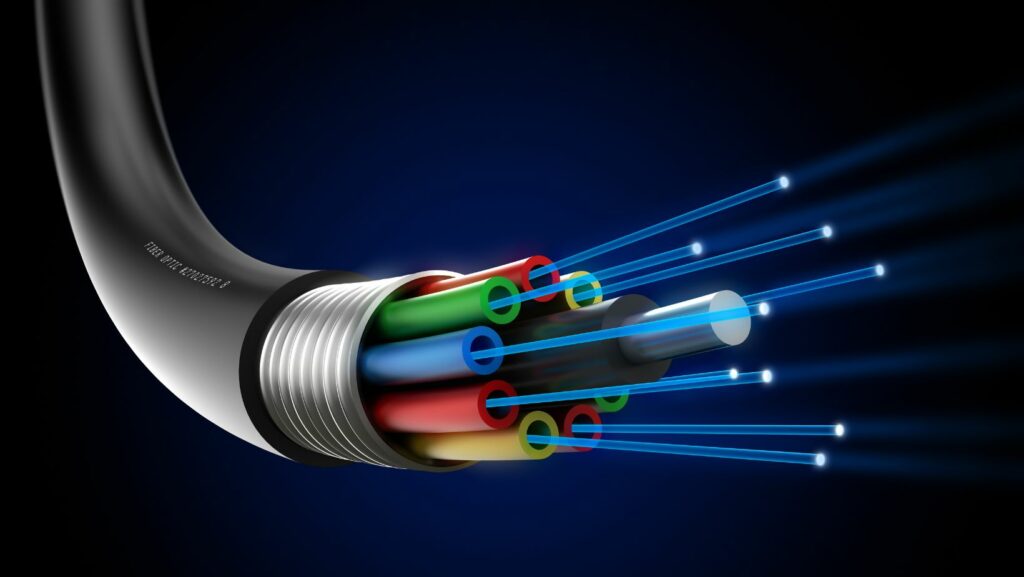Within the world of connectivity, fiber optic cable solutions stand out as silent heroes, revolutionizing data transmission. Imagine a technology so advanced that it can enhance speed, security, and reliability simultaneously.
How do these slender strands of glass manage to outshine traditional copper wires in more ways than one? As we explore the intricacies of fiber optic cables, you will uncover the secrets behind this game-changing innovation and its implications for the digital landscape.
The Basics of Fiber Optic Cables
When setting up a fiber optic network, understanding the fundamental principles of fiber optic cables is crucial for successful implementation. Fiber optic cables come in different types, each designed for specific purposes. Single-mode fibers are ideal for long-distance communication due to their ability to transmit light signals over greater distances with minimal loss. On the other hand, multi-mode fibers are better suited for shorter distances where high bandwidth is required.
The components of a fiber optic cable include the core, which carries the light signals, the cladding that surrounds the core and reflects the light back into the core, and the buffer coating that protects the core and cladding from damage. When installing fiber optic cables, it’s essential to handle them carefully to prevent any bends or kinks that could disrupt the light transmission. Regular maintenance is also crucial to ensure optimal performance, such as cleaning connectors and inspecting cables for any signs of wear or damage.
Advantages of Using Fiber Optics
To fully grasp the benefits of utilizing fiber optics in your network infrastructure, it’s essential to understand the significant advantages they offer over traditional copper cables. Fiber optics provide unparalleled speed benefits compared to copper cables. Data can travel much faster over fiber optic cables due to the transmission of light instead of electrical signals, resulting in quicker data transfer rates and reduced latency in your network operations.
Additionally, fiber optics offer enhanced security features. Since fiber cables don’t emit electromagnetic signals, they aren’t susceptible to electromagnetic interference or radio-frequency interference, making them highly secure for transmitting sensitive data. The data transmitted over fiber optics is also more challenging to tap into, providing an added layer of security for your network communications.
Applications Across Various Industries
Across various industries, fiber optic cables are utilized for their high-speed data transmission capabilities and enhanced security features. In industrial automation, fiber optic cables play a crucial role in ensuring rapid and reliable communication between machines, sensors, and control systems. The low latency and high bandwidth of fiber optics make them ideal for real-time monitoring and control applications in manufacturing plants, warehouses, and other industrial settings.
In the field of medical imaging, fiber optic cables enable the transmission of high-definition images with exceptional clarity and detail. Medical professionals rely on fiber optic technology to perform minimally invasive procedures, such as endoscopy and laparoscopy, with precision and accuracy. The ability of fiber optics to transmit light over long distances without loss or interference makes them indispensable in medical devices like endoscopes and imaging systems.
How Fiber Optics Are Changing Communication
With the evolution of fiber optic technology, communication methods are undergoing a significant transformation in terms of speed and reliability. Fiber optics have revolutionized data transmission by enabling the transfer of large amounts of data at incredibly high speeds over long distances. This technology is reshaping network infrastructure by replacing traditional copper wires with optical fibers that can carry data through pulses of light.
The use of fiber optics in communication systems ensures minimal signal loss, making it a more reliable option compared to traditional methods. These cables are immune to electromagnetic interference, providing a stable connection for uninterrupted data flow. As a result, businesses and individuals can now enjoy faster internet speeds, clearer voice calls, and smoother video streaming experiences.
Furthermore, fiber optics aren’t only changing communication within local networks but also globally. They play a crucial role in undersea cables that connect continents, facilitating international data exchange at remarkable speeds. This transformation in communication infrastructure is paving the way for a more connected world where information can be shared instantaneously across borders.
Future Innovations in Fiber Optic Technology
In the realm of fiber optic technology, upcoming innovations are poised to revolutionize data transmission capabilities with enhanced speed and efficiency. One of the most anticipated advancements is the integration of quantum encryption into fiber optic networks. Quantum encryption utilizes the principles of quantum mechanics to secure data in a way that’s theoretically impossible to hack, ensuring unparalleled levels of data security for sensitive information transmitted through fiber optic cables.
Moreover, the evolution of fiber optic technology is expected to play a crucial role in the development of smart cities. By leveraging fiber optic networks, smart cities can efficiently collect and analyze vast amounts of data from various sensors and devices to optimize services and infrastructure, enhance public safety, and improve overall quality of life for residents. The high-speed and high-capacity capabilities of fiber optics will be instrumental in powering the interconnected systems that characterize smart city initiatives, making urban environments more sustainable, efficient, and responsive to the needs of citizens.
Conclusion
As you journey through the vast landscape of communication technology, fiber optic cables stand as beacons of innovation, illuminating the path ahead with their unmatched speed and reliability.
Like a guiding light cutting through the darkness, fiber optics pave the way for seamless connectivity across industries and regions.
Embrace the power of fiber optics and let them lead you towards a brighter, more connected future.



